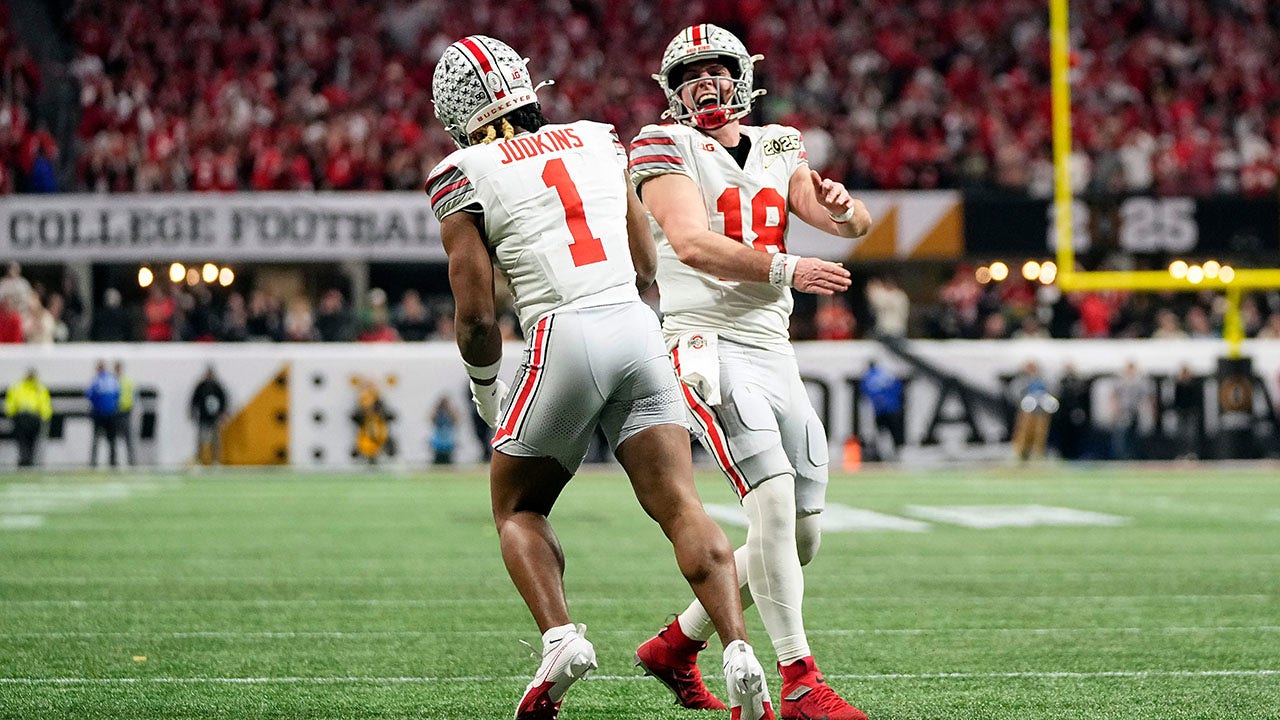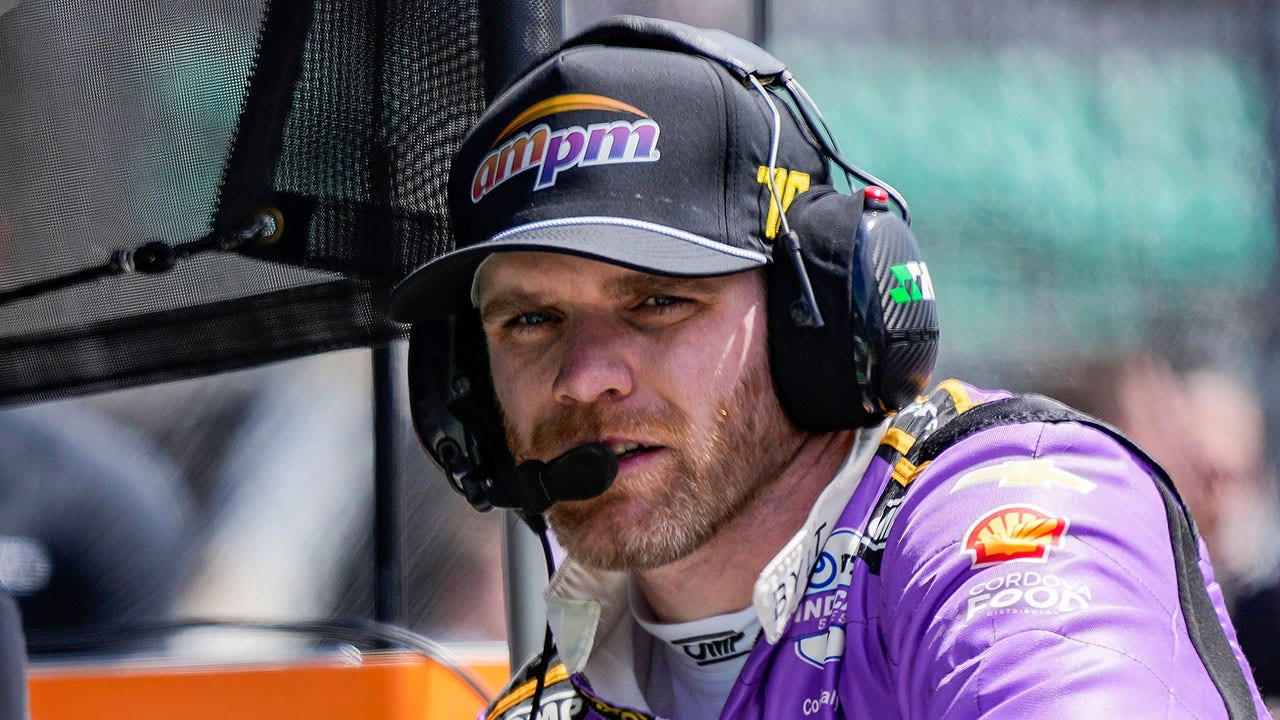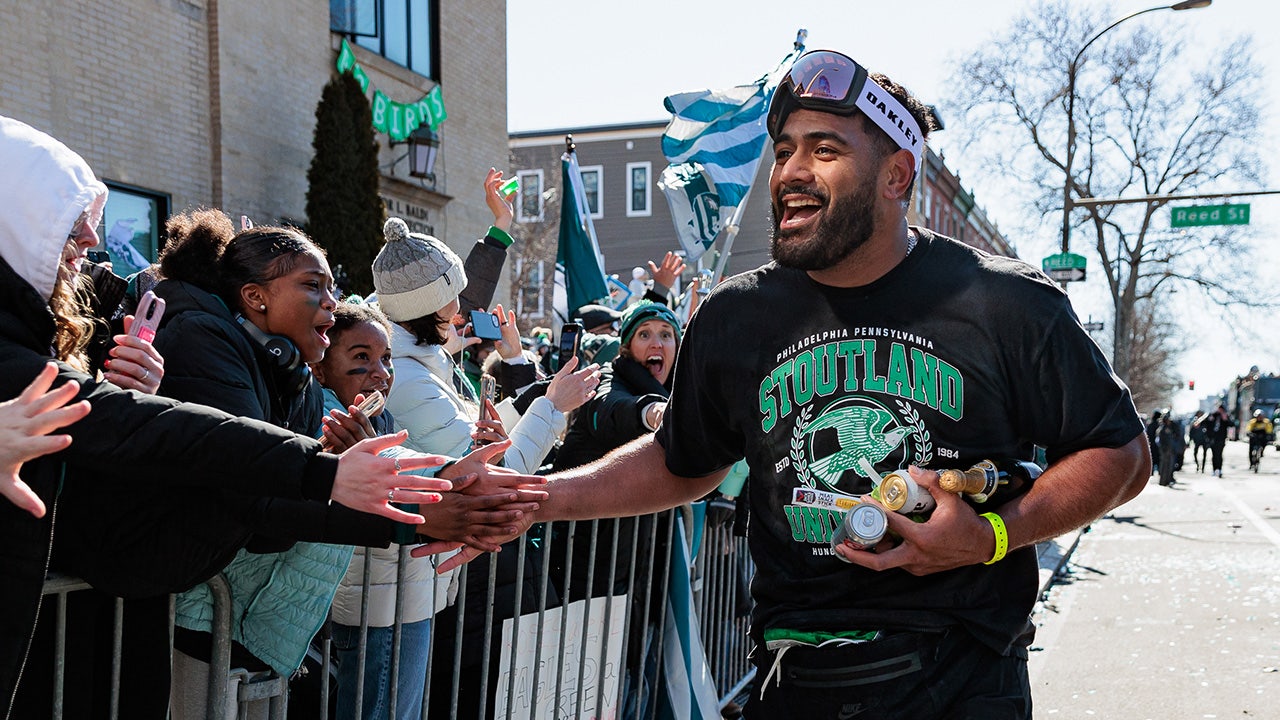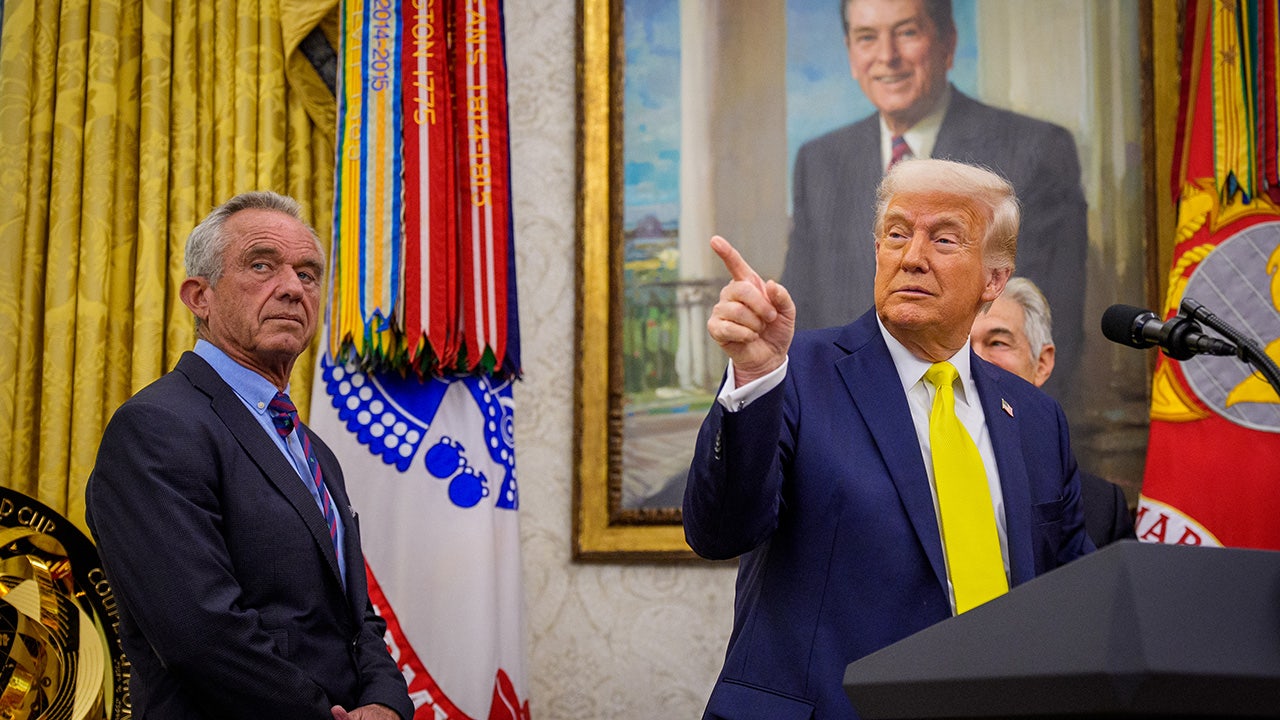Sports
Ohio State holds off Notre Dame to win college football national championship

The Buckeyes are back on top, as Ohio State took down Notre Dame, 34-23, to win the College Football Playoff National Championship Game at Mercedes-Benz Stadium in Atlanta on Monday night.
Ohio State has now won nine college football titles, tying them with USC for fourth-most ever among NCAA’s officially recognized championships.
This is also the first title since the 2014 season, which was the inaugural College Football Playoff.
Ohio State Buckeyes wide receiver Jeremiah Smith (4) celebrates with offensive lineman Donovan Jackson (74) after a touchdown catch against Notre Dame Fighting Irish in the first quarter during the College Football Playoff National Championship at Mercedes-Benz Stadium in Atlanta on January 20, 2025. (IMAGN)
The Buckeyes have been such a different team since losing to Michigan in their rivalry game. And after convincingly defeating Tennessee (42-17), Oregon in the Rose Bowl (41-21), and Texas in the Cotton Bowl (28-14), Ohio State used their high-octane offense to barrel its way past Notre Dame to win it all.
But this game wasn’t like previous Ohio State wins during this playoff, as the Fighting Irish really made a statement on an opening drive that lasted 18 plays and killed over nine minutes of first quarter clock.
And it was all thanks to the hard work by quarterback Riley Leonard and the Notre Dame offensive line.
NOTRE DAME, OHIO STATE MEETING IN COLLEGE FOOTBALL NATIONAL CHAMPIONSHIP WITH FAITH AT FOREFRONT
Leonard ran nine times for 34 yards and scored after picking up a fourth-and-1 on Ohio State’s five-yard line. ESPN even reported that Leonard ran to the sideline, threw up and stumbled a bit before sitting on the bench. He also appeared to tell teammates that he landed on the ball on one of the runs, which could’ve caused the upset stomach.
However, the tides of momentum quickly shifted to the Ohio State sideline, as Will Howard and his group of talented weapons didn’t just respond, but took over when they had the ball in their hands.
The ensuing drive went 11 plays and 75 yards, as freshman phenom Jeremiah Smith capped the drive with a perfect play call that saw him act like he was running behind Howard on pre-snap motion but planting in the ground and walking into the end zone with no one in sight.
Ryan Day’s group not only tied the game, but the defense turned it up a notch as they forced back-to-back three-and-outs on Notre Dame’s second and third drive. And the Buckeyes’ offense used that to their advantage with two more touchdown drives before the end of the first half.

Ohio State Buckeyes running back Quinshon Judkins (1) celebrates a touchdown catch with tight end Gee Scott Jr. (88) against Notre Dame Fighting Irish in the second quarter during the College Football Playoff championship at Mercedes-Benz Stadium in Atlanta on January 20, 2025. (IMAGN)
Quinshon Judkins, the explosive running back that splits time with TreVeyon Henderson, scored both of those touchdowns, the first of which being a nine-yard run where he fought through multiple tackles to get across the line. Then, he was wide open in the end zone on a rolling throw by Howard with 27 seconds left in the second quarter to put the Buckeyes up 21-7.
And if that wasn’t deflating enough, Judkins scored his third touchdown of the night on the first drive of the second half – a one-yard run that was set up by his 70-yard run on the second play of the half to immediately get the Buckeyes first-and-goal.
Judkins finished the game with 100 rushing yards on just 11 carries as well as his two catches for 21 yards.
There was some concern for Ohio State, though, when Notre Dame cut it to a two-score game after Leonard found Jaden Greathouse for a 34-yard touchdown and converted the two-point try to make it 31-15.
COLLEGE FOOTBALL STAR ASHTON JEANTY TALKS POSSIBILITY OF DEION SANDERS COACHING COWBOYS
The concern was due to an Emeka Egbuka fumble after going 24 yards on a catch-and-run. It was the first Ohio State fumble since their game against Penn State on Nov. 2.
Notre Dame used that turnover to drive downfield, and Leonard found himself knocking on the doorstep until an incomplete pass to Greathouse made it fourth-and-goal from Ohio State’s nine-yard line with 9:27 left to play in the game.

Ohio State head coach Ryan Day celebrates after a touchdown by running back Quinshon Judkins during first half of the College Football Playoff national championship game Monday, Jan. 20, 2025, in Atlanta. (AP Photo/Brynn Anderson)
Given the score, one would think head coach Marcus Freeman wanted to try his luck at another touchdown, but kicker Mitch Jeter and the special teams unit ran out onto the field. And the interesting play call backfired, as Jeter’s 27-yard field goal attempt ran off the left goal post – he hooked it.
The game wasn’t over entirely after the defense forced a punt, and Leonard was able to find Greathouse once again, this time on a beautifully thrown ball and an even better catch from 30 yards out. Needing another two-point conversion, Jordan Faison took a handoff and it looked like Ohio State sniffed it out, but he threw it to Beaux Collins for the successful try.
Now a one-score game, the Buckeyes had to dig deep with the Fighting Irish knowing a stop gave them a chance to make the comeback complete.
Backed up with third-and-11, offensive coordinator Chip Kelly called a gutsy deep pass from Howard to Smith, and despite the freshman not having a single reception in the second half, he secured the dagger – a 57-yard catch to place the Buckeyes on the nine-yard line at the two-minute warning.
The Buckeyes could run out the clock at that point with the Fighting Irish using all of their timeouts, and the celebrating ensued.

Ohio State Buckeyes quarterback Will Howard (18) celebrates a touchdown with running back Quinshon Judkins (1) against Notre Dame Fighting Irish in the second quarter during the College Football Playoff National Championship at Mercedes-Benz Stadium in Atlanta on January 20, 2025. (IMAGN)
In the box score, Leonard was 20-for-29 for 240 yards with two touchdowns, while also rushing for a team-high 40 yards on 17 carries with his score on the ground. Greathouse had 11 yards on five receptions as well.
For the Buckeyes, Smith led the way with his 89 yards on five receptions, while Egbuka had six catches for 64 yards. Howard finished the game 17-of-21 for 231 yards, and he also rushed for 57 yards on 16 carries.
Follow Fox News Digital’s sports coverage on X, and subscribe to the Fox News Sports Huddle newsletter.

Sports
Conor Daly looks to etch his name in more than just Indy 500 history

NEWYou can now listen to Fox News articles!
Conor Daly will roll off pit road at Indianapolis Motor Speedway for the Indianapolis 500 with the obvious goal in mind – win the race and cement himself in racing lore for the rest of time.
A victory will do more than just make him a part of Indy 500 history forever; he will become a folk hero for his native Indiana, which is itching to see a lengthy drought end.
Juncos Hollinger Racing driver Conor Daly, #76, high-fives crew members on Saturday, May 17, 2025 during qualifying for the 109th running of the Indianapolis 500 at Indianapolis Motor Speedway. (Grace Hollars/IndyStar / USA TODAY NETWORK via Imagn Images)
It has been 85 years since an Indiana-born race car driver won the illustrious race. Daly will be driving the No. 76 ampm-sponsored Chevrolet with Wilbur Shaw on his mind, almost literally. Shaw won three Indy 500 races, but no one from Indiana has won it since 1940.
He will be wearing a helmet that honors the legendary driver on Sunday.
“It’s crazy, 85 years since the last Indy 500 winner from Indiana. That just seems wrong. It just seems sad. So we’ve got to change that,” Daly, who was born in Noblesville, told Fox News Digital. “It was just a cool idea that I came up with my helmet painter.
“I try to come up with something unique every year for the Indy 500 helmet because it’s just a special event, and we put a couple old picture of his car from back in the day – 1940 was the last winner, which is crazy. Put the 1940 ticket on top of the helmet as well with a couple of little small details.”
Daly qualified 11th for the race and is set to start in between Scott McLaughlin and Alexander Rossi, who have both won the race in the past.
He touted how fast the car has been for him. His average speed during qualifying was around 231 mph.

Juncos Hollinger Racing driver Conor Daly, #76, sits on the wall on Monday, May 19, 2025 after practice for the 109th running of the Indianapolis 500 at Indianapolis Motor Speedway in Indianapolis on May 19, 2025. (Grace Hollars-USA TODAY NETWORK via Imagn Images)
INDYCAR DRIVER CONOR DALY GOES RACING WITH AMPM FOR THE INDY 500
“I feel really good,” he said. “This is one of the best cars I’ve had in my IndyCar career here, and I know that’s a bold statement to say, but it’s truly been a pleasure to drive all week. I’ve equaled my best starting position with 11th. We’re right alongside the pole-sitter from last year, Scott McLaughlin. We’re in the fight. … This car is just flat out fast and that’s really, really special.”
He called driving at such a high rate of speed “truly crazy.”
“I don’t know why you wouldn’t watch what we’re doing here because it truly is crazy,” he explained. “We’re at that level where cars are flying through the air, crashing at a high level, because we are putting these things on the absolute ragged edge of control and that’s what it takes to win the biggest race out there.
“It’s the biggest race that there is across motorsports. Some people like to argue that but physically, if you ask any racing drivers who have been around the sport for a long time, the Indy 500, that’s the big one. It’s crazy and what we’re doing out there is wild.”
Daly said winning the Indy 500 would be a realization of all the hard work he has put in throughout his entire career.
“It’s why I wake up every morning,” the Juncos Hollinger Racing driver told Fox News Digital.
Most importantly, he already has the milk picked out that he will chug should he be able to.

Juncos Hollinger Racing driver Conor Daly, #76, makes his way out of turn one on Monday, May 19, 2025 during practice for the 109th running of the Indianapolis 500 at Indianapolis Motor Speedway in Indianapolis. (Mykal McEldowney-USA TODAY NETWORK via Imagn Images)
“I’ve gone whole milk the last few years, but I haven’t won yet,” he said. “So, I decided to switch it up. We’re gonna go 2% because why not? Let’s pick something different and maybe that’ll get us the win.”
The Indy 500 will be broadcast May 25 on FOX with coverage starting at 10 a.m. ET. It will also be available to stream live on FOXSports.com and the FOX Sports app.
Follow Fox News Digital’s sports coverage on X, and subscribe to the Fox News Sports Huddle newsletter.
Sports
NFL owners vote to keep 'Tush Push,' the Super Bowl champion Eagles' signature play

NFL owners have decided to keep the “Tush Push,” the signature short-yardage play of the defending Super Bowl champion Philadelphia Eagles, after a vote Wednesday at their spring meeting in Eagan, Minnesota.
Multiple media outlets are reporting that the vote was 22-10 in favor of the ban, falling short of the 24 votes it needed to go into effect. The teams that are said to have joined the Eagles in voting against the proposal were the Baltimore Ravens, Cleveland Browns, Detroit Lions, Jacksonville Jaguars, Miami Dolphins, New England Patriots, New Orleans Saints, New York Jets and Tennessee Titans.
The “Tush Push” is a version of a quarterback sneak in which two or three players line up behind the signal caller and help drive him forward in short-yardage situations.
The Eagles — who also call the play the “Brotherly Shove” — have been nearly flawless in executing the push since 2022, with two-time Pro Bowl quarterback Jalen Hurts carrying the ball. During that span, ESPN reports, the Eagles and Buffalo Bills have run the play more than the rest of the NFL combined, with a far greater success rate (87% for Philadelphia and Buffalo compared to 71% for the rest of the league).
Also during the past three seasons, the Eagles have scored 27 touchdowns and recorded 92 first downs using the play, according to ESPN.
A proposal by the Green Bay Packers to ban the play was tabled at the NFL’s annual league meeting in April. The Packers submitted a revision this week to prohibit “an offensive player from pushing, pulling, lifting or assisting the runner except by individually blocking opponents for him.”
The initial proposal had called for those restrictions only to be in effect “immediately at the snap.”
After the results of the vote came out, the Eagles posted a graphic on X showing Hurts and the Philadelphia offense lining up against the Packers defense, with the caption, “Push on.” The Eagles also posted a 26-minute video of “Tush Push” highlights on YouTube.
NFL commissioner Roger Goodell told reporters he did not take a stance on the proposal.
The proposal cited “player safety” and “pace of play” as reasons for the ban, although many opponents of the play seem to focus on the former argument. The NFL has no conclusive data that shows a link between the push and an increased injury risk.
Others have questioned the play’s place in football, suggesting it is more of a rugby move, and that its perceived automatic nature, at least when the Eagles run it, is bad for the game.
Eagles coach Nick Sirianni defended his team’s use of the play while speaking with reporters in February.
“We work really, really hard, and our guys are talented at this play. And so it’s a little insulting to say just because we’re good at it, it’s automatic,” he said.
“The fact that it’s a successful play for the Eagles and people want to take that away, I think it’s a little unfair.”
Eagles owner Jeffrey Lurie and retired Philadelphia center Jason Kelce addressed the team owners Wednesday before the vote. Kelce had explained on the most recent episode on his and brother Travis Kelce‘s “New Heights” podcast that he was going to Minneapolis “to answer any questions people have” about the safety of the play.
“I’m just going to offer, if anybody has any questions about the tush push, or whether I retired because of the tush push, I’ll tell you, I’ll come out of retirement today if you tell me, ‘All you gotta do is run 80 tush pushes to play in the NFL,’” Kelce said. “I’ll do that gladly. It’ll be the easiest job in the world.”
Sports
Jordan Mailata, other Eagles stars downplay tush push as NFL vote on team's signature play looms

Should the Eagles’ Tush Push be banned? | Breakfast Ball
The Green Bay Packers have proposed a rule to ban the “Tush Push”, and the Philadelphia Eagles felt “insulted” by this. Craig Carton, Danny Parkins, and Mark Schlereth debate over whether or not the tush push should be banned.
NEWYou can now listen to Fox News articles!
The NFL owners are expected to reengage in talks about the polarizing tush push on Wednesday at league meetings.
Last month, owners tabled the vote on a proposal to ban the play that became the Philadelphia Eagles’ calling card over the past couple of seasons. As the vote nears, some prominent Philadelphia Eagles spoke out about the controversial short yardage play.
Philadelphia Eagles offensive tackle Jordan Mailata (68) celebrates during the Super Bowl LIX championship parade and rally. (Caean Couto-Imagn Images)
“I don’t have any thoughts on it,” Eagles wide receiver A.J. Brown said. “It’s only one yard.”
Offensive lineman Jordan Mailata echoed similar sentiments, saying: “They’re ruling [on] the push? I guess we’ll just do it with no push.
“In terms of them banning the tush push, I hate that name, so I hope they do ban it — it’s a stupid name,” the All-Pro tackle joked.
COMMANDERS’ FRANKIE LUVU CHIMES IN ON ‘CHEAPO’ PUSH AS NFL TEAM OWNERS WEIGH BAN
“But I can’t control it. We can’t control it. So, we don’t even worry about it. Right now, we’re just installing our schemes, whatever [offensive coordinator Kevin Patullo] is installing that day, that’s what we’re focused on because worrying about if they’re going to ban the tush push or not ain’t going to win us a championship.”

Philadelphia Eagles quarterback Jalen Hurts (1) lines up for the tush push play on the goal line against the Kansas City Chiefs during Super Bowl LIX at Ceasars Superdome. (Mark J. Rebilas-Imagn Images)
.The Green Bay Packers submitted a proposal to ban the tush push.
“We’ll see where that goes,” Eagles coach Nick Sirianni said. “We’re not waiting very long to figure it out. It’s going to be public [Wednesday]. And you know how I feel about it.”

Philadelphia Eagles quarterback Jalen Hurts (1) scores on the tush push during a game between the San Francisco 49ers and the Philadelphia Eagles on Dec. 3, 2023. (Andy Lewis/Icon Sportswire via Getty Images)
At last month’s league meetings, Eagles owner Jeffrey Lurie described the tush push as “precision play” and credited quarterback Jalen Hurts for helping make the play routinely successful.
ESPN reported that the tush push was utilized in just 0.28% of total plays last season.
Follow Fox News Digital’s sports coverage on X, and subscribe to the Fox News Sports Huddle newsletter.
-

 Education1 week ago
Education1 week agoA Professor’s Final Gift to Her Students: Her Life Savings
-

 Politics1 week ago
Politics1 week agoPresident Trump takes on 'Big Pharma' by signing executive order to lower drug prices
-

 Education1 week ago
Education1 week agoHarvard Letter Points to ‘Common Ground’ With Trump Administration
-

 Culture1 week ago
Culture1 week agoBook Review: ‘Original Sin,’ by Jake Tapper and Alex Thompson
-

 Culture1 week ago
Culture1 week agoTest Yourself on Memorable Lines From Popular Novels
-

 News1 week ago
News1 week agoAs Harvard Battles Trump, Its President Will Take a 25% Pay Cut
-

 News1 week ago
News1 week agoWhy Trump Suddenly Declared Victory Over the Houthi Militia
-

 News1 week ago
News1 week agoAustin Welcomed Elon Musk. Now It’s Weird (in a New Way).




















